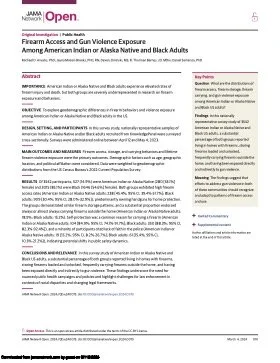By Michael D Anestis , Jayna Moceri-Brooks , Devon Ziminski , R Thurman Barnes , Daniel Semenza
Importance: American Indian or Alaska Native and Black adults experience elevated rates of firearm injury and death, but both groups are severely underrepresented in research on firearm exposure and behaviors.
Objective: To explore geodemographic differences in firearm behaviors and violence exposure among American Indian or Alaska Native and Black adults in the US.
Design, setting, and participants: In this survey study, nationally representative samples of American Indian or Alaska Native and/or Black adults recruited from KnowledgePanel were surveyed cross-sectionally. Surveys were administered online between April 12 and May 4, 2023.
Main outcomes and measures: Firearm access, storage, and carrying behaviors and lifetime firearm violence exposure were the primary outcomes. Demographic factors such as age, geographic location, and political affiliation were considered. Data were weighted to geodemographic distributions from the US Census Bureau's 2022 Current Population Survey.
Results: Of 3542 participants, 527 (14.9%) were American Indian or Alaska Native (280 [53.1%] female) and 3015 (85.1%) were Black (1646 [54.6%] female). Both groups exhibited high firearm access rates (American Indian or Alaska Native adults: 238 [45.4%; 95% CI, 39.4%-51.7%]; Black adults: 909 [30.4%; 95% CI, 28.0%-32.9%]), predominantly owning handguns for home protection. The groups demonstrated similar firearm storage patterns, and a substantial proportion endorsed always or almost always carrying firearms outside the home (American Indian or Alaska Native adults: 18.9%; Black adults: 15.2%). Self-protection was a common reason for carrying a firearm (American Indian or Alaska Native adults: 104 [84.9%; 95% CI, 74.1%-91.7%]; Black adults: 350 [88.3%; 95% CI, 82.3%-92.4%]), and a minority of participants cited lack of faith in the police (American Indian or Alaska Native adults: 19 [15.2%; 95% CI, 8.2%-26.7%]; Black adults: 61 [15.4%; 95% CI, 10.3%-21.2%]), indicating potential shifts in public safety dynamics.
Conclusions and relevance: In this survey study of American Indian or Alaska Native and Black US adults, a substantial percentage of both groups reported living in homes with firearms, storing firearms loaded and unlocked, frequently carrying firearms outside the home, and having been exposed directly and indirectly to gun violence. These findings underscore the need for nuanced public health campaigns and policies and highlight challenges for law enforcement in contexts of racial disparities and changing legal frameworks.
JAMA Netw Open, 2024





















